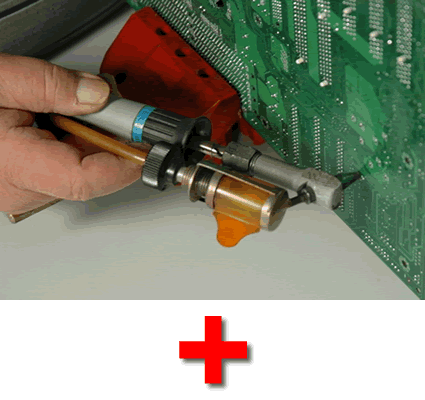How to Fix Your Motherboard for $15
When a Motherboard Fails
Hardware failures can have mysterious faces - computer crashes, display anomalies or read/write errors when accessing a hard drive. Usually, what you do is install new drivers, then you look at adjusting settings within your operating system, you search BIOS for relevant options or go the whole nine yards and exchange components such as the main memory. But your computer just won't run smoothly.
Not only operating systems or device drivers cause system malfunctions. Not even the latest hardware such as quad core processors and terabyte hard drives can prevent hardware failures. Hardware manufacturers typically define a certain lifetime for every component of your computer or laptop. This tends to be five years for hard drives, but other components may have longer life expectancies. Building blocks such as processors, memory, motherboards or graphics card usually keep working for much longer - if always operated and cooled properly. But no crystal ball can tell you precisely how long an electronic product will last.
Electrolytic capacitors on numerous semiconductor-based products such as motherboards or graphics cards can often cause computer to behave strangely if they fail. What can you do if malfunctioning motherboard capacitors are the reason for trouble with your computer? If the mobo is under warrantee you can return it for a replacement. If you have to exchange a faulty motherboard for a new and different one, you may also need new memory as well as a new processor. There is a considerably less expensive solution. You can replace faulty electrolytic capacitors yourself. I will show you how to revive a motherboard or graphics card Compare Prices on Video Cards with the right tools and for very little money.
Join our discussion on this topic
Get Tom's Hardware's best news and in-depth reviews, straight to your inbox.
Current page: When a Motherboard Fails
Next Page Capacitors - Mysterious Creatures-
Darkness Master Recognizing of broken capacitors is not so simple in some cases.Reply
Sometimes (very often in my case) have capacitor its nominal capacity but it has high serial current. When you connect DC voltage of capacitor nominal value and capacitor have some serial current throught it, then it is broken. Only charging current is allowed (short current peak on connect).
Sorry for my english. -
4655434b20594f55 Good article. I have personally made this repair sucessfully many times using only a basic hand held solding iron and hand held desolder pump.Reply
Like you say the motherboard sinks away the heat fast. You need an iron with between 70 and 100 watts and a large flat tip. If it spans both solder points of the cap its really easy :)
Just heat and gently pull the cap out from the other side of the board. Then clear the holes with the heated pin method or use a desolder pump. If you heat the hole on one side and use the pump on the other side it should clear easily.
Only other thing to note is. Be QUICK, practice on some junk board first, you dont want to burn a big hole in your board or lift of the tracks.
Im sure most people don't have a professional solder/desolder station. These cost at least $160 usually more. -
4655434b20594f55 Another trick. Assuming the old caps are dead and of no further use. Pull them off thier leads.Reply
If you pull a electrolytic capacitor hard the leads will pull straight out of the body of the cap.
Leaving just the leads sticking up. Its now much easier to remove becuase you can desolder the leads and remove them one at a time. -
Just trim the leads sticking out of the bottom of the board then heat one at a time while applying slight pressure to the capacitor towards the other lead. They pop right out. I use thecapking for capacitors online, fast free shipping.Reply
-
I use the Weller WLC100. It's consumer DIY soldering station, but more than meets the needs for motherboard soldering. Runs about $50. I've done 50+ boards easily with this station, but I use a precision tip instead of the big tip it comes with (usually run about $10). I also recommend Mouser or Digikey for capacitors, though beginners may find these sites overwhelming. TheCapking is a good place to find capacitor kits for common motherboards with faulty capacitors, and the site has diagrams in case you get confused where the capacitors need to go.Reply
-
runf I Turned on a computer that had been working. A short "pop", a fairly intense burning odor, and later I found a capacitor (I presume) on the bottom of my computer case:Reply
Here is a pic of the Asus P5-K. The green arrow points to where the capacitor used to sit.
http://jazzdrummer.com/capacitor2.jpg
First of all I'd like to know if it is indeed a capacitor and if not, what it is. Whatever it is, can I get another, solder it in and have any hope of fixing this board? I'm really clueless, if you can't tell. Any help would be greatly appreciated. This could be an opportunity for me to learn something. -
gabs110 I have a MSI mobo which I repaired some months back...replaced 2 caps. Lately, the same symptoms re-occured..pc starts up, fans run, lights light up but nothing else..no sound, no bios, no display. I replaced the same caps again thinking it might be malfunctioning but still nothing and no signs of any other failure. Any advice? My pc is a Acer Veriton M464 duo core.Reply -
Greg Hopkins Once you pull a mother board for any bad caps, you should replace them all. The caps are cheap compared to the down time and frustration. Some caps can fail with no obvious signs from the outside. My advise would be to change all the old caps with new low ESR Caps.Reply

